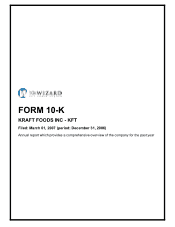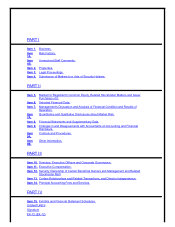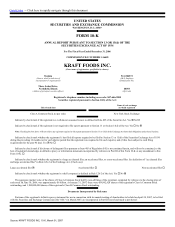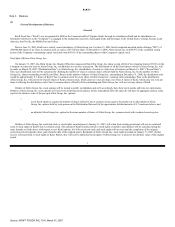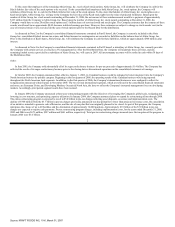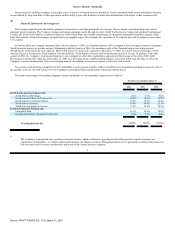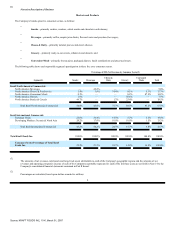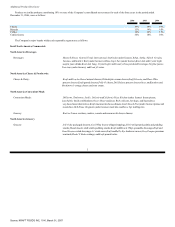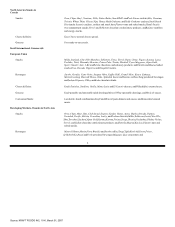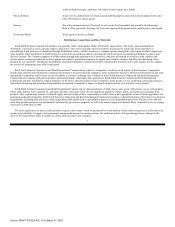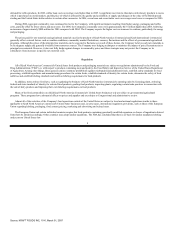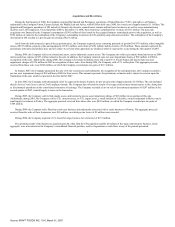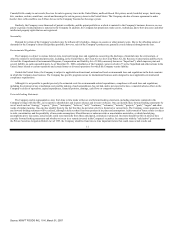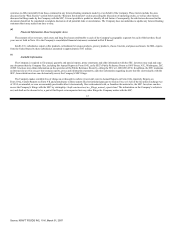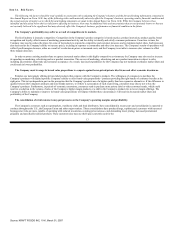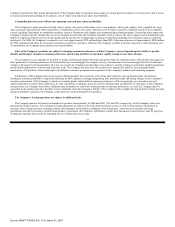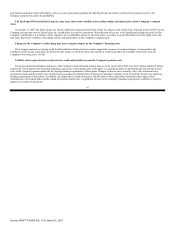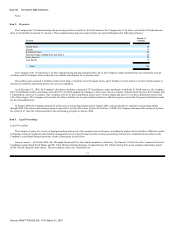Kraft 2006 Annual Report Download - page 11
Download and view the complete annual report
Please find page 11 of the 2006 Kraft annual report below. You can navigate through the pages in the report by either clicking on the pages listed below, or by using the keyword search tool below to find specific information within the annual report.
ready-to-drink beverages; andCapri Sun (under license) aseptic juice drinks.
Cheese & Dairy: Kraft, Velveeta andEden process cheeses;Kraft andPhiladelphia cream cheese;Kraft natural cheese; and
Cheez Whiz process cheese spread.
Grocery: Royal dry packaged desserts;Post ready-to-eat cereals;Kraft spoonable and pourable salad dressings;
Miracle Whip spoonable dressings;Jell-O dessert toppings;Kraft peanut butter; andVegemite yeast spread.
Convenient Meals: Kraft macaroni & cheese dinners.
Distribution, Competition and Raw Materials
Kraft North America Commercial's products are generally sold to supermarket chains, wholesalers, supercenters, club stores, mass merchandisers,
distributors, convenience stores, gasoline stations, drug stores, value stores and other retail food outlets. In general, the retail trade for food products is
consolidating. Food products are distributed through distribution centers, satellite warehouses, company-operated and public cold-storage facilities, depots and
other facilities. Most distribution in North America is in the form of warehouse delivery, but biscuits and frozen pizza are distributed through two direct-store
delivery systems. The Company supports its selling efforts through three principal sets of activities: consumer advertising in broadcast, print, outdoor, and
on-line media; consumer promotions such as coupons and contests; and trade promotions to support price features, displays and other merchandising of our
products by our customers. Subsidiaries and affiliates of Kraft International Commercial sell their food products primarily in the same manner and also engage
the services of independent sales offices and agents.
Kraft North America Commercial and Kraft International Commercial are subject to competitive conditions in all aspects of their business. Competitors
include large national and international companies and numerous local and regional companies. Some competitors may have different profit objectives and some
international competitors may be more or less susceptible to currency exchange rates. Products of Kraft North America Commercial and Kraft International
Commercial also compete with generic products and retailer brands, wholesalers and cooperatives. Kraft North America Commercial, Kraft International
Commercial and their subsidiaries compete primarily on the basis of product quality, brand recognition, brand loyalty, service, marketing, advertising and price.
Substantial advertising and promotional expenditures are required to maintain or improve a brand's market position or to introduce a new product.
Kraft North America Commercial and Kraft International Commercial are major purchasers of milk, cheese, nuts, green coffee beans, cocoa, corn products,
wheat, pork, poultry, beef, vegetable oil, and sugar and other sweeteners. They also use significant quantities of glass, plastic and cardboard to package their
products. They continuously monitor worldwide supply and cost trends of these commodities to enable them to take appropriate action to obtain ingredients and
packaging needed for production. Kraft North America Commercial and Kraft International Commercial purchase a substantial portion of their dairy raw material
requirements, including milk and cheese, from independent third parties such as agricultural cooperatives and independent processors. The prices for milk and
other dairy product purchases are substantially influenced by government programs, as well as by market supply and demand. Dairy commodity costs on average
were lower in 2006 than in 2005.
The most significant cost item in coffee products is green coffee beans, which are purchased on world markets. Green coffee bean prices are affected by the
quality and availability of supply, trade agreements among producing and consuming nations, the unilateral policies of the producing nations, changes in the
value of the United States dollar in relation to certain other currencies and consumer
7
Source: KRAFT FOODS INC, 10-K, March 01, 2007

